Last week we presented two fashion illustrations: English Suits from the 1960s. Continuing the vintage menswear coverage, we want to focus on several pictures of 1960s suits from German bespoke tailors. In fact, the photographs were taken 1962 and represent the spring summer fashion at the time. At this point in time, there were still thousands of bespoke tailors in Germany and the German suit industry was a leader in Europe.
Sportscoat
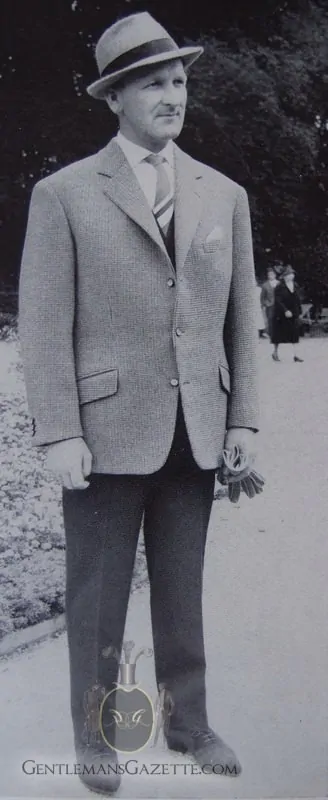
First of all, let’s look at this gentleman in his sportscoat ensemble. The sportscoat is a classic, single breasted 3 button coat with angled flap pockets – aka hacking pockets. They are angled towards the closing buttons, creating a more dynamic impression. I am not sure how tall this person is, but based on the rather low positioning of the pockets, I assume he is between 5’5″ to 5’6″ (about 1.70m). Interestingly, the quarters in the front and fairly open but cut pretty straight at the bottom. The small checked fabric has front darts and the full cut sleeves are set in beautifully – just look at the line of the sleeve. Try to find that feature on a modern suit off the rack – it is almost impossible.
The lapels are of average size and very typical for the period. Personally, I like the lapel roll – it almost transforms this 3 Button jacket into a 3-roll 2 button sportscoat.
The shirt collar and coat collar fit tightly around the neck, without any gaps and the tie has these 60s style pattern in the middle of the tie.
Underneath his coat, he wears a cardigan or sweater vest in a darker color.
The trousers do not feature cuffs, but are tapered towards the ankle and drape very nicely. Some may argue that he does not show any cuff, but since this is a sportscoat that looks great all around, and I am certain this was done intentionally that way.
Overall, the fit is great!
Single Breasted Suit with Ticket Pocket
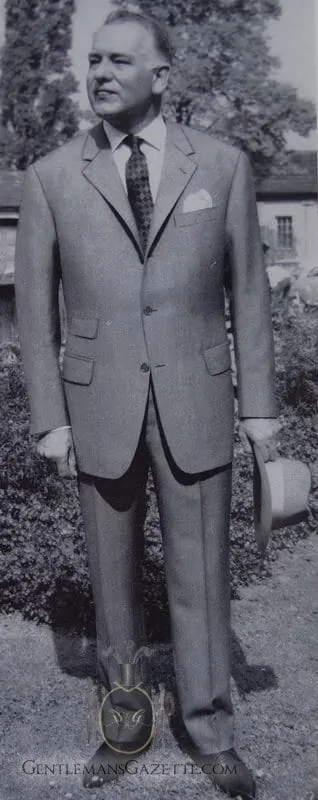
Next, we can see a seasoned gentleman wearing a light grey single breasted suit with straight flap pockets that line up with the lower button. The ticket pocket above sits pretty much at the natural waist, and the closing button ever so slightly above. The quarters here are more open, similar to modern day men’s fashion. They have a more elegant line since they are a little longer at the curve and not just cut straight.
The torso appears to be very long, and you can tell that this person is taller than the one in the first picture. Unlike the Italian barchetta chest pocket, German pockets were cut neatly and straight. Altogether, this suit – just like all the others – looks almost razor sharp because the tailors used heavier fabric and stiffer interlinings to create this flawless appearance.
The semi spread collar, the patterned tie and s the hat are typical for the period.
Double Breasted Suit
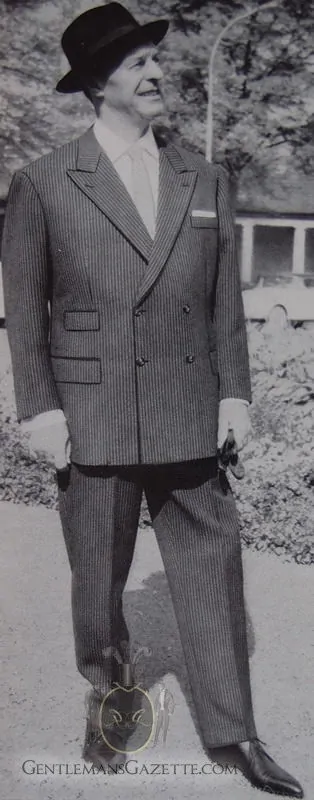
The only double breasted suit in this selection is typical for the 1960s. As outlined before, the 4×2 button configuration was en vogue and the lapels had not reached the 10cm (4″) width you sometimes observe today.
Traditionally, a double breasted suit was always more formal and proper than a single breasted suit. Today, Lino from Al Bazaar et al have given the double breasted suit a distinctly soft look and feel. Though back in the sixties, this was absolutely different.
As such this gentleman about town wears a black hat and black shoes as well as a white shirt with this ensemble. The white pocket square is folded properly and overall the look is anything but sprezzatura.
Despite that, I really like this outfit. The coat is great, it hangs beautifully from the shoulder without creating any gaping along the hem – just look how straight and flat it lays. The pockets align with the buttons and the slightly wider cut trousers fall nicely even though he stands at an angle.
Interestingly, he wears the same style of pointed derby shoes as all the other men. While most men would find them borderline effeminate, back in the 60s this was the absolute standard men’s shoe in Germany.
Up until the 1960s a pair of gloves were just as essential as the hat, or even more so. Even during the summer, a proper gentleman would always have a pair of unlined gloves! In case it was too hot, he would carry them along as a kind of an accessory. Also, although he wears a very conservative outfit with black hat and black shoes, he does not have black gloves – they were simply not worn back then.
1960s Suit for Young People
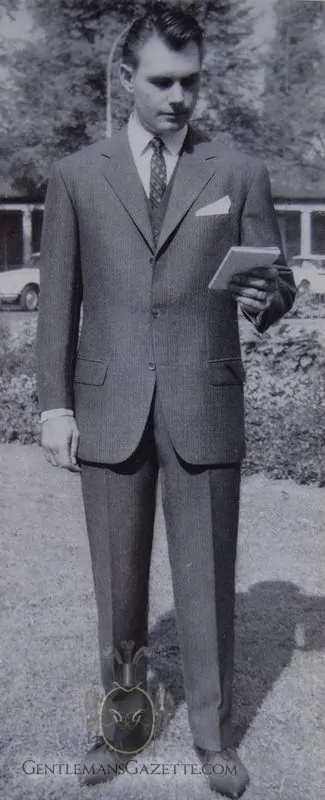
The young person’s single breasted suit is very similar to the others we have seen. None of them had cuffs and they all look razor sharp. The waist is a little more tapered here, the tie is a little slimmer, but just like in the first picture, this young man wears a cardigan or sweater vest underneath.
Note, the really pointed brogue shoes – that looks a bit extreme to me, doesn’t it?
Unlike fashion illustrations, vintage pictures clearly show us what people wore back then and how well the suits fit. Admittedly, these are all bespoke garments and so it does not come as a surprise that they fit so well, but also RTW garments looked very different from today.
Which one is your favorite suit and why? Would you commission a 1960s suit from your tailor?
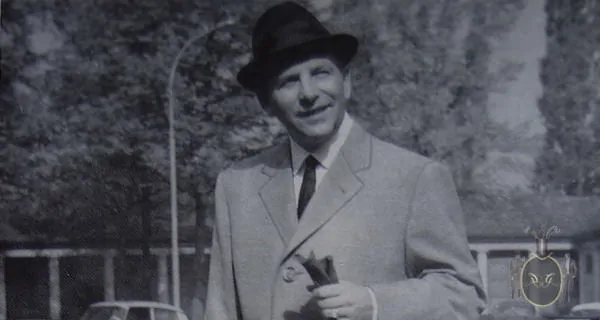
Very nice 60thies styles. The sport coat is just a single normal coat. In the beginning of the 60thies the pockets had a distance of 25cm from the hem. In the end of the 60thies the pockets raised 2cm higher to get a more modern style. The chest ease in the 60thies was terrible big, Today this would be a no go. Also the waist suppression was tiny, caused by a distant position of the side panel. The fabric at that time was thick and heavy and could take a lot of ease in the sleeve cap. Still today it is possible to cut a full sleeve cap if you work traditional with the older sleeve drafts and if the tailor knows what he is doing.
Not to have a single wrinkle in those suits is only possible with German engineering craftsmanship. This technique is almost vanished and only a couple of tailors like me still know how to do that. Those master pieces are not made by some village slip knot tailors, today this quality starts at 4000$ plus.
The cloth of all suits must be wonderfully heavy. Not a single wrinkle. Marvellous ! Personally, I like the double breasted one best. Thanks a lot again for this article.
You are welcome!
Thanks for your comments Uwe. I’d be happy to see a number of pictures of your suits so we can present them to our readers. You know how to reach me, don’t you?
We could establish a Berlin Bespoke Tailoring in the USA. Berlin was once in 1928 the city of fashion before Paris. Berlin had so many tailors and cutting schools like no other city in the world. Berlin was the capital of bespoke tailoring at that time. Those cutting schools which existed until the end of WW II in Germany set the beginning of engineering tailoring, wrinkleless coats and trousers like in those pictures here to be seen. Whilst London keeps tailoring like in the 1900, Germany moved 50 years forward in developing new modern, full proof cutting systems and modern making techniques leaving the tailoring world behind. Many anglophile customers are not aware of those backgrounds. The same is valid for the Italian tailoring. The difference is that the German tailoring didn’t really pick up the Italian style. So Italian tailoring is an own standing style and deserves his love of his customers, like the German/American/English style.
Dear Mr. Schönherr,
I must thank you for your comments. I was so far not aware at all of the facts you explained here and those I’ve read about in your website.
Unfortunately, it also made me aware of what our now styleless country has lost with this art.
Mr. Gernot, indeed, the art is lost. Your sentence hits the spot. It is sad, but tailoring was an unthankful profession since the beginning. Tailors never made real money, there was no family to feed. The needle sometimes became heavy like concrete. There are not many tailors left anymore now.